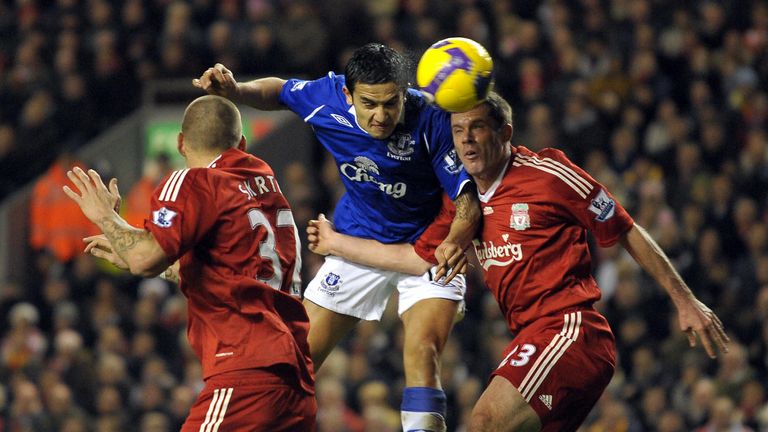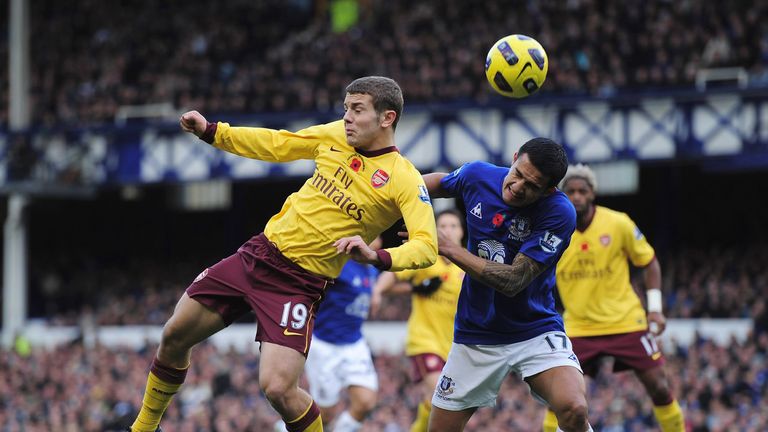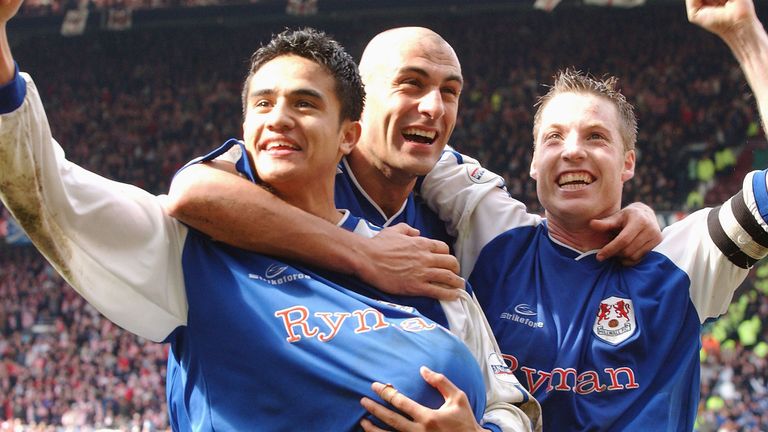Tim Cahill and the art of heading in the Premier League | Off Script
"Before every game, my analysis was important. I wanted to know who the weakest centre-back was. I timed my runs, and ran off the shoulder of the weaker defender."
Wednesday 18 September 2019 16:11, UK
In the latest edition of Off Script, former Everton attacking midfielder Tim Cahill explains the fine details of how he mastered the art of heading in the Premier League.
The Australian scored 31 of his 56 Premier League goals with his head, and was nicknamed the Blue Kangaroo by his adoring fans at Goodison Park.
Here, speaking with Geoff Shreeves in the latest Off Script, he explains step-by-step how he would get the better of his markers in the penalty area, and how growing up among a family of rugby lovers toughened him up for his move to England at 16.
'The goal never moves'
Firstly, it's technique training. Making sure you can head a ball cleanly. The main thing I say when I train young kids, is: "The goal never moves."
Secondly, you find chemistry with players. I had Hibbo [Tony Hibbert], Mikel Arteta, Bainsey [Leighton Baines] and Steven Pienaar. Their movement would be control, then set, then cross. I knew the likelihood of a cross hitting the back post was higher, and in my favour. That's why you never saw me go near post, because it would more than likely go over my head.
Another important thing was my timing of run, and running off the shoulder of the weaker defender, particularly the person who is playing as a six in the midfield and has dropped into defence.
Before every game, my analysis was important. I wanted to know who the weakest centre-back was, and who could turn off his left shoulder better than his right. If I was up against an Ashley Cole at left-back or a Branislav Ivanovic at right-back, I'd pick Ashley Cole as the set. You must go into detail with all the little things in the game, and then be smart enough to use your power tool.
I had a high fitness calibre, so was able to keep running into the box, and a lot of goals would be scored late on.
'I played to my strengths'
Plyometrics is big in football; working in the gym, and not only on your legs but your upper body, too. I wasn't the quickest, I wasn't somebody who shot much outside the box, but I played to my strengths. I had good chemistry with my players, and I always worked on defence first with my heading ability, so I would be the first man at the near post, meaning the cross would have to miss me out to have a chance. That was a big thing.
Defensively, I was in a line with Sylvain Distin, Marouane Fellaini, Phil Jagielka, Lee Carsley. There's only one ball, so if you're zonally marking, just go and attack the ball and win the header. If two of you could do that, that's important.
'I liked being marked!'
I liked being marked, because that defender can only watch the ball. I liked to feel the player up against me, and when he wrapped his arms around me, I liked to pull his arms down, release and then move. If you look at Tammy Abraham's movement for his headed goal on Saturday against Wolves, it's not just one movement, it's away, and then forward. The movements must be quick instincts.
But also, if you're being zonally marked, you can just stand still and allow everyone to run forward and get caught in the melee. For me, you have to play the elements, but I like being marked, because it would be a physical battle between him and I, and nine times out of 10 he was watching the ball, and I'd back myself.
'Philosophy is paramount'
When you look at styles of play, philosophies, like Manchester City, it's runs in-behind, into pockets, and when they get into the danger area it's a fizzed ball on the floor. So, either the defender misses it, the defender scores an own goal, or the defender clears for a corner or a throw in. There are those dinks, like we saw with Marcos Alonso into Abraham on Saturday, so it really depends on the philosophy of the football team.
English football is renowned for crossing, second balls, headers, and it is changing a little bit. But for me, when you look at games in general, I like looking for the third-man runner, the deep-lying midfielder, whether a No 10 or a holder, ghosting in from behind. I want to see more midfielders breaking in and scoring.
David Platt and Frank Lampard were brilliant at that. Particularly Frank, and I'm enjoying seeing how he's coaching Mason Mount, almost into the player he was.
'Visualise your goal'
For most athletes, it's nice to go out and spend a moment before the game visualising where you're going to score, how you're going to score, and if that 18-yard box is bobbly and poor, I definitely want that ball in the air.
I always visualised goals, visualised defenders that I'm playing with, and when they're going to get tired.
'Rugby helped me mentally'
I obviously couldn't have been a rugby player with this physique at 75kgs! My mother is from Samoa, which has a heavy culture of rugby, both league and union. My cousins played in the NRL, and I used to play with them. I had a big heart, and playing with them, I'd try to run through brick walls, but I'd always be the one kid crying at the end. So, I had to change my game.
I think playing rugby with my cousins helped me mentally growing up, to always dust myself off and go again. Coming to England as a 16-year-old, understanding how difficult it would be to earn a contract, and even just to be seen in training, was a big thing for me. Rugby is a big part of my upbringing, and learning their traits; respect, being humble, and off the pitch, always shaking hands after a battle on the pitch.









